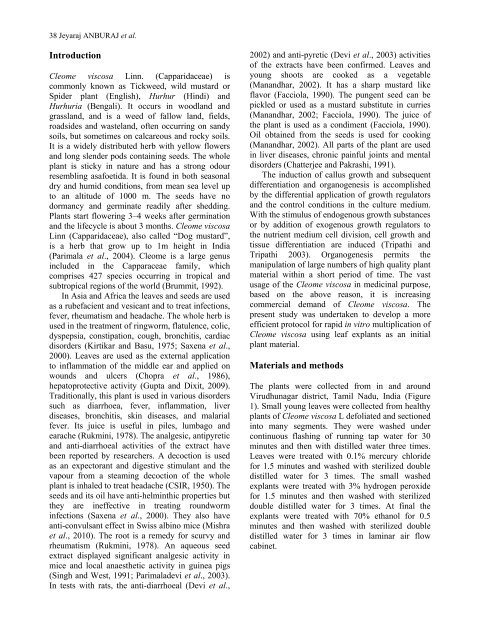Vol 9 No1 - Journal of Cell and Molecular Biology - Haliç Üniversitesi
Vol 9 No1 - Journal of Cell and Molecular Biology - Haliç Üniversitesi
Vol 9 No1 - Journal of Cell and Molecular Biology - Haliç Üniversitesi
Create successful ePaper yourself
Turn your PDF publications into a flip-book with our unique Google optimized e-Paper software.
38 Jeyaraj ANBURAJ et al.<br />
Introduction<br />
Cleome viscosa Linn. (Capparidaceae) is<br />
commonly known as Tickweed, wild mustard or<br />
Spider plant (English), Hurhur (Hindi) <strong>and</strong><br />
Hurhuria (Bengali). It occurs in woodl<strong>and</strong> <strong>and</strong><br />
grassl<strong>and</strong>, <strong>and</strong> is a weed <strong>of</strong> fallow l<strong>and</strong>, fields,<br />
roadsides <strong>and</strong> wastel<strong>and</strong>, <strong>of</strong>ten occurring on s<strong>and</strong>y<br />
soils, but sometimes on calcareous <strong>and</strong> rocky soils.<br />
It is a widely distributed herb with yellow flowers<br />
<strong>and</strong> long slender pods containing seeds. The whole<br />
plant is sticky in nature <strong>and</strong> has a strong odour<br />
resembling asafoetida. It is found in both seasonal<br />
dry <strong>and</strong> humid conditions, from mean sea level up<br />
to an altitude <strong>of</strong> 1000 m. The seeds have no<br />
dormancy <strong>and</strong> germinate readily after shedding.<br />
Plants start flowering 3–4 weeks after germination<br />
<strong>and</strong> the lifecycle is about 3 months. Cleome viscosa<br />
Linn (Capparidaceae), also called “Dog mustard”,<br />
is a herb that grow up to 1m height in India<br />
(Parimala et al., 2004). Cleome is a large genus<br />
included in the Capparaceae family, which<br />
comprises 427 species occurring in tropical <strong>and</strong><br />
subtropical regions <strong>of</strong> the world (Brummit, 1992).<br />
In Asia <strong>and</strong> Africa the leaves <strong>and</strong> seeds are used<br />
as a rubefacient <strong>and</strong> vesicant <strong>and</strong> to treat infections,<br />
fever, rheumatism <strong>and</strong> headache. The whole herb is<br />
used in the treatment <strong>of</strong> ringworm, flatulence, colic,<br />
dyspepsia, constipation, cough, bronchitis, cardiac<br />
disorders (Kirtikar <strong>and</strong> Basu, 1975; Saxena et al.,<br />
2000). Leaves are used as the external application<br />
to inflammation <strong>of</strong> the middle ear <strong>and</strong> applied on<br />
wounds <strong>and</strong> ulcers (Chopra et al., 1986),<br />
hepatoprotective activity (Gupta <strong>and</strong> Dixit, 2009).<br />
Traditionally, this plant is used in various disorders<br />
such as diarrhoea, fever, inflammation, liver<br />
diseases, bronchitis, skin diseases, <strong>and</strong> malarial<br />
fever. Its juice is useful in piles, lumbago <strong>and</strong><br />
earache (Rukmini, 1978). The analgesic, antipyretic<br />
<strong>and</strong> anti-diarrhoeal activities <strong>of</strong> the extract have<br />
been reported by researchers. A decoction is used<br />
as an expectorant <strong>and</strong> digestive stimulant <strong>and</strong> the<br />
vapour from a steaming decoction <strong>of</strong> the whole<br />
plant is inhaled to treat headache (CSIR, 1950). The<br />
seeds <strong>and</strong> its oil have anti-helminthic properties but<br />
they are ineffective in treating roundworm<br />
infections (Saxena et al., 2000). They also have<br />
anti-convulsant effect in Swiss albino mice (Mishra<br />
et al., 2010). The root is a remedy for scurvy <strong>and</strong><br />
rheumatism (Rukmini, 1978). An aqueous seed<br />
extract displayed significant analgesic activity in<br />
mice <strong>and</strong> local anaesthetic activity in guinea pigs<br />
(Singh <strong>and</strong> West, 1991; Parimaladevi et al., 2003).<br />
In tests with rats, the anti-diarrhoeal (Devi et al.,<br />
2002) <strong>and</strong> anti-pyretic (Devi et al., 2003) activities<br />
<strong>of</strong> the extracts have been confirmed. Leaves <strong>and</strong><br />
young shoots are cooked as a vegetable<br />
(Man<strong>and</strong>har, 2002). It has a sharp mustard like<br />
flavor (Facciola, 1990). The pungent seed can be<br />
pickled or used as a mustard substitute in curries<br />
(Man<strong>and</strong>har, 2002; Facciola, 1990). The juice <strong>of</strong><br />
the plant is used as a condiment (Facciola, 1990).<br />
Oil obtained from the seeds is used for cooking<br />
(Man<strong>and</strong>har, 2002). All parts <strong>of</strong> the plant are used<br />
in liver diseases, chronic painful joints <strong>and</strong> mental<br />
disorders (Chatterjee <strong>and</strong> Pakrashi, 1991).<br />
The induction <strong>of</strong> callus growth <strong>and</strong> subsequent<br />
differentiation <strong>and</strong> organogenesis is accomplished<br />
by the differential application <strong>of</strong> growth regulators<br />
<strong>and</strong> the control conditions in the culture medium.<br />
With the stimulus <strong>of</strong> endogenous growth substances<br />
or by addition <strong>of</strong> exogenous growth regulators to<br />
the nutrient medium cell division, cell growth <strong>and</strong><br />
tissue differentiation are induced (Tripathi <strong>and</strong><br />
Tripathi 2003). Organogenesis permits the<br />
manipulation <strong>of</strong> large numbers <strong>of</strong> high quality plant<br />
material within a short period <strong>of</strong> time. The vast<br />
usage <strong>of</strong> the Cleome viscosa in medicinal purpose,<br />
based on the above reason, it is increasing<br />
commercial dem<strong>and</strong> <strong>of</strong> Cleome viscosa. The<br />
present study was undertaken to develop a more<br />
efficient protocol for rapid in vitro multiplication <strong>of</strong><br />
Cleome viscosa using leaf explants as an initial<br />
plant material.<br />
Materials <strong>and</strong> methods<br />
The plants were collected from in <strong>and</strong> around<br />
Virudhunagar district, Tamil Nadu, India (Figure<br />
1). Small young leaves were collected from healthy<br />
plants <strong>of</strong> Cleome viscosa L defoliated <strong>and</strong> sectioned<br />
into many segments. They were washed under<br />
continuous flashing <strong>of</strong> running tap water for 30<br />
minutes <strong>and</strong> then with distilled water three times.<br />
Leaves were treated with 0.1% mercury chloride<br />
for 1.5 minutes <strong>and</strong> washed with sterilized double<br />
distilled water for 3 times. The small washed<br />
explants were treated with 3% hydrogen peroxide<br />
for 1.5 minutes <strong>and</strong> then washed with sterilized<br />
double distilled water for 3 times. At final the<br />
explants were treated with 70% ethanol for 0.5<br />
minutes <strong>and</strong> then washed with sterilized double<br />
distilled water for 3 times in laminar air flow<br />
cabinet.

















